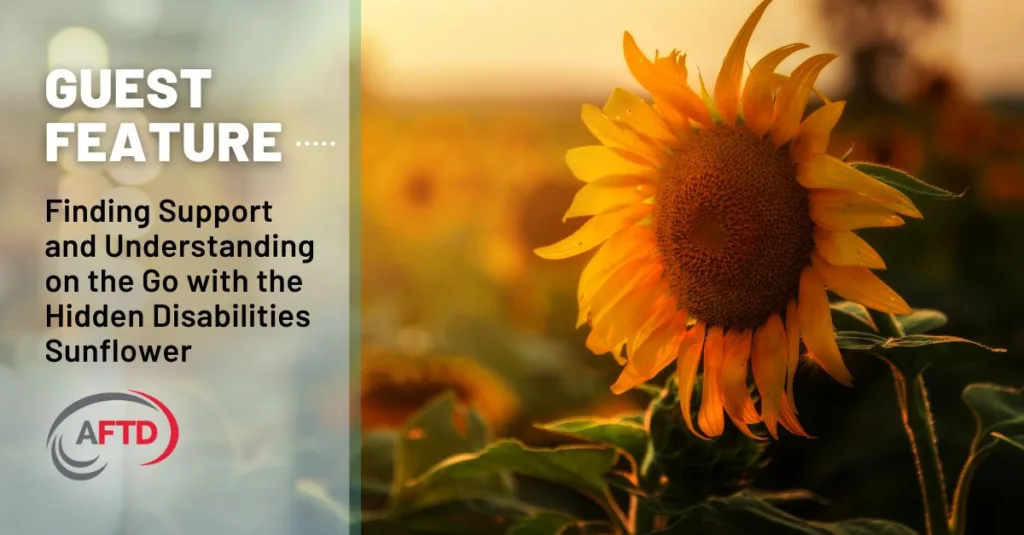Guest Feature: Finding Support and Understanding on the Go with the Hidden Disabilities Sunflower

For persons diagnosed with FTD, simply existing in public can be challenging. FTD’s symptoms can cause difficulties while shopping, ordering food, or participating in social activities. Traveling – with its lines, security checks, crowds, and tight quarters – adds further complexity.
Because FTD isn’t widely known, the public generally won’t be aware of the challenges that persons diagnosed face. Raising awareness of FTD will gradually let affected families more easily participate in public activities, but today there is still a need for supportive resources.
The Hidden Disabilities Sunflower is a tool that lets families affected by FTD find support and understanding for the challenges they face in their communities and on the go. The Sunflower is a card worn on a lanyard to signify that the user has a disability that is not outwardly apparent but creates difficulties. Wearing the Sunflower signals that a person might need extra help, understanding, and more time to accomplish tasks.
Viva and Bruce Boerschel, part-time care partners for their son, Bob, told AFTD that the Sunflower can help persons diagnosed find support when in town or traveling.
“Most everyone would look at [the card] and recognize it,” Viva said. “It’s made me feel more calm and comfortable. Bob appreciates having it on as well; he doesn’t feel like he’s being pointed out.”
Bob’s Experience
Bob is living with behavioral variant FTD (bvFTD) caused by an inherited genetic variant. In addition to personality changes, bvFTD can cause apathy, and impact a person’s judgment and inhibition. Symptoms of bvFTD are not exclusively behavioral; Bob, for example, also has difficulty with speech and is slow to respond, Viva and Bruce said.
Bob enjoys traveling, his parents said, noting that that traveling together is a boon to the three of them. While bvFTD’s symptoms can create complicate ctravel, Viva and Bruce said that using the Sunflower card has made travel much more accessible.
“I had one person at the counter say ‘Oh, I think I’ve heard about that! Tell me about that program,’” Viva said. “She was appreciative of us explaining what it meant. I think some people have had training on it.”
Once, Bob was struggling to speak while at a service counter. The clerk noticed Bob’s Sunflower card and took the time to help him sort through his paperwork, without prompting from Viva or Bruce. During a different trip, Bob got away from Viva and Bruce, going to their flight’s gate early after mishearing an announcement. The gate agent, however, noticed Bob’s Sunflower card and helped him board the plane anyway.
Bob’s wife, Erin, first obtained his Sunflower card by contacting Delta Airlines. The card not only helps make travel accessible, it also helps Bob feel safer while doing so. Bruce and Viva noted that the card has applications outside of travel, giving Bob greater accessibility around town and helping him feel safe while out with Erin, Bruce, or Viva.
“I would like him to use [the card] more when we go to grocery stores,” Viva said. “It could be useful in gas stations, clothing stores, and restaurants.”
Support for Travel and Shopping
The Hidden Disabilities Sunflower program began in the U.K. and is more prominently known there and in some European countries. Some U.K. grocery chains, such as Morrisons and Tesco, train their employees to recognize the lanyards and provide appropriate support. The lanyard is more widely recognized at airports and train stations, but is also used at many primary and secondary schools in the U.K.
While not as well known in the U.S. retail market, Hidden Disabilities Sunflower is used at many airports around the country. Lanyards may often be obtained from airports’ information desks, though it is recommended to check the airport’s website first. Some airlines, such as Delta, Qantas, and Air Canada, participate in the Sunflower program.
For more information about where the Sunflower program is used in the U.S., or to get a card of your own, visit the organization’s website.
By Category
Our Newsletters
Stay Informed
Sign up now and stay on top of the latest with our newsletter, event alerts, and more…
